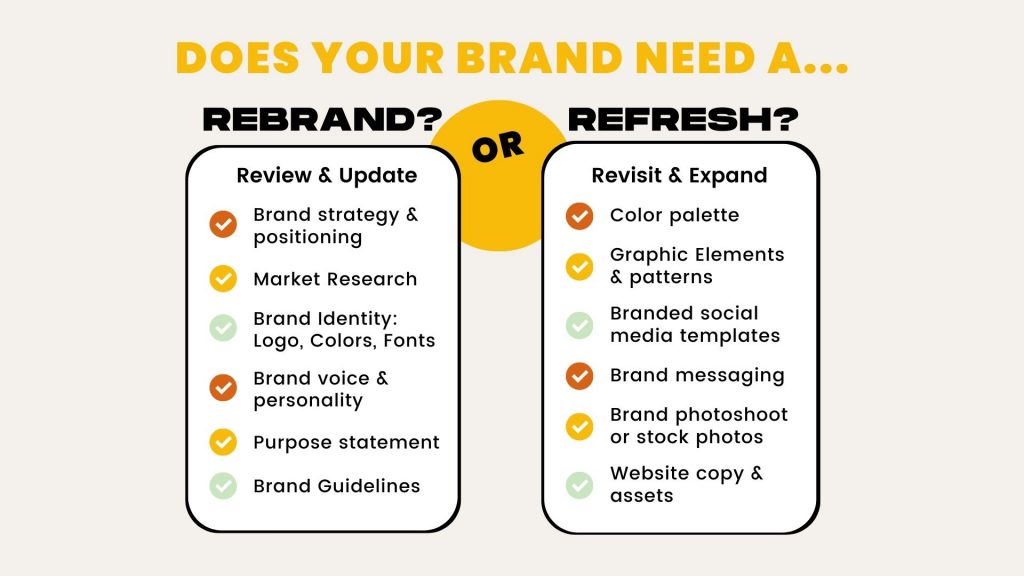- Have any questions?
- +91 96020 93137
- +91 93525 62080
- info@worldseoservices.com
Rebranding Done Right: When and How to Refresh Your Brand

Personal Branding 101: Establishing Your Unique Digital Footprint
December 28, 2024
Social Media Branding: Strategies for Building a Consistent Online Presence
December 28, 2024Offer guidance on recognizing the need for rebranding and executing it without alienating loyal customers.
In the fast-paced world of business, staying relevant is critical to success. Markets evolve, customer preferences shift, and competition grows—making it necessary for brands to evolve too. Rebranding, when done thoughtfully, can breathe new life into your business, help you stay competitive, and strengthen your connection with your audience.
At World SEO Services, we understand that the decision to refresh your brand is a significant one, and doing it right requires strategy, creativity, and precision. Here’s a comprehensive guide to understanding when and how to refresh your brand for maximum impact.

Why Consider Refreshing Your Brand?
Rebranding isn’t just about updating your logo or changing your tagline; it’s about reshaping your identity to align with your evolving goals, values, and audience expectations. Here are some common reasons to consider rebranding:
- Outdated Identity: Your brand looks or feels outdated compared to current industry trends.
- Market Expansion: You’re entering new markets or targeting a different demographic.
- Negative Perception: Your brand may have suffered from a public relations issue or other setbacks.
- Mergers and Acquisitions: Rebranding helps unify the identity of two or more companies.
- Shifts in Offerings: If your products or services have evolved, your brand should reflect these changes.
When Should You Refresh Your Brand?
Timing is everything when it comes to rebranding. Here are some key indicators that it’s time for a brand refresh:
- Customer Feedback: If customers express confusion or dissatisfaction with your brand.
- Declining Engagement: Reduced interaction on social media, lower sales, or decreased website traffic.
- Competitive Pressure: Competitors with more modern or appealing branding gain an edge over you.
- Internal Evolution: Your company’s mission, vision, or values have changed.
Pro Tip: A brand refresh doesn’t always mean a complete overhaul. Sometimes, subtle changes to your design or messaging are all you need to stay relevant.

Key Elements of a Brand Refresh
Refreshing your brand involves rethinking several elements of your identity. Here’s what you should focus on:
1. Visual Identity
Your logo, colors, typography, and overall design should resonate with modern aesthetics and your target audience.
Action Steps:
- Update your logo for simplicity and versatility.
- Revise your color palette to reflect current design trends or evoke desired emotions.
- Choose modern typography that complements your brand personality.
2. Messaging and Tone
Your brand’s voice should align with your audience’s language and preferences.
Action Steps:
- Update your tagline to reflect your current mission.
- Revise your website copy, social media bios, and marketing materials to ensure consistency.
3. Customer Experience
Evaluate how customers interact with your brand at every touchpoint.
Action Steps:
- Redesign your website for better user experience (UX).
- Refresh your product packaging for a more contemporary look.
- Align customer service practices with your brand’s updated persona.
4. Digital Presence
Your online presence plays a vital role in rebranding success.
Action Steps:
- Redesign your social media profiles with updated visuals and content.
- Create a content strategy that reflects your brand’s new direction.
- Optimize your website for SEO with relevant keywords, like “Refresh Your Brand.”
How to Execute a Successful Brand Refresh
A brand refresh requires careful planning and execution. Here’s a step-by-step guide:
1. Conduct a Brand Audit
Evaluate your current brand’s strengths, weaknesses, and overall perception.
Action Steps:
- Gather feedback from customers, employees, and stakeholders.
- Analyze competitors to identify gaps and opportunities.
- Review your brand’s performance metrics, such as website traffic and social media engagement.
2. Define Your Goals
Set clear objectives for your rebranding efforts.
Questions to Ask:
- What do you want to achieve with your brand refresh?
- Who is your target audience?
- How will you measure success?
3. Develop a Rebranding Strategy
Create a detailed plan for your brand refresh, including timelines and budgets.
Key Components:
- Visual and messaging updates.
- Marketing and communication strategies.
- Internal training to ensure team alignment.
4. Involve Your Audience
Engage your audience throughout the rebranding process to build anticipation and loyalty.
Tips:
- Share behind-the-scenes content on social media.
- Conduct polls or surveys to gather input on potential changes.
- Launch a teaser campaign to create excitement around your new brand.
5. Roll Out Your New Brand
Execute your rebranding plan with precision.
Action Steps:
- Update all digital and physical assets, including websites, social media profiles, business cards, and signage.
- Announce your rebrand with a compelling launch campaign.
- Monitor and adjust based on audience feedback and analytics.

Case Study: Successful Brand Refresh
Example: Old Spice
Old Spice is a textbook example of a successful rebrand. Once considered outdated, the brand revamped its image with humorous and modern advertising campaigns targeting younger audiences. The result? A significant boost in sales and cultural relevance.
Key Takeaway: A well-executed brand refresh can completely transform how your business is perceived.
Common Pitfalls to Avoid in Rebranding
- Lack of Research: Failing to understand your audience and market can lead to misaligned changes.
- Inconsistency: Ensure all elements of your rebrand are cohesive.
- Overcomplication: Keep your messaging and visuals simple and clear.


